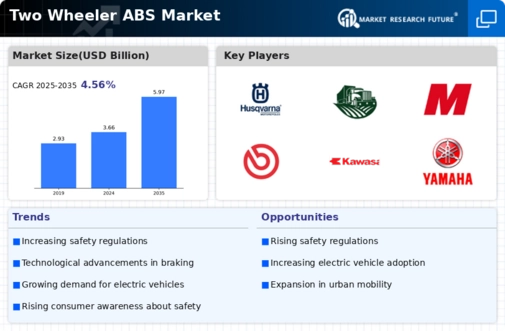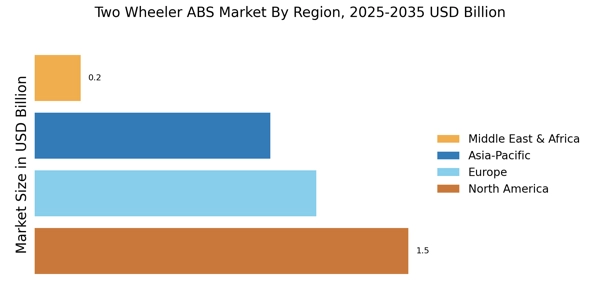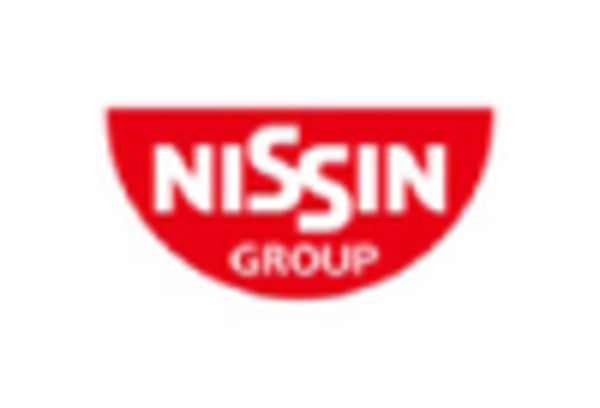Technological Advancements in ABS
The Two Wheeler ABS Market is experiencing a surge in technological advancements, particularly in anti-lock braking systems. Innovations such as advanced sensors and electronic control units are enhancing the performance and reliability of ABS. These developments are not only improving safety but also increasing consumer confidence in two-wheelers equipped with ABS. According to recent data, the adoption rate of ABS in two-wheelers has risen significantly, with estimates suggesting that nearly 40% of new models are now equipped with this technology. This trend is likely to continue as manufacturers invest in research and development to create more efficient and effective braking systems. As a result, the Two Wheeler ABS Market is poised for substantial growth, driven by the demand for safer riding experiences.
Shift Towards Electric Two-Wheelers
The Two Wheeler ABS Market is also being influenced by the growing shift towards electric two-wheelers. As electric vehicles gain popularity, manufacturers are increasingly incorporating ABS into their electric models to ensure safety and performance. The integration of ABS in electric two-wheelers is essential, as these vehicles often have different braking dynamics compared to traditional gasoline-powered models. Market data indicates that the electric two-wheeler segment is projected to grow at a compound annual growth rate of over 20% in the coming years. This growth is likely to drive the demand for ABS technology, as consumers prioritize safety features in their purchasing decisions. Consequently, the Two Wheeler ABS Market is adapting to this trend, with manufacturers focusing on developing ABS systems tailored for electric two-wheelers.
Competitive Landscape and Innovation
The competitive landscape of the Two Wheeler ABS Market is characterized by rapid innovation and strategic partnerships among manufacturers. Companies are increasingly investing in advanced braking technologies to differentiate their products in a crowded market. This competition is fostering an environment where continuous improvement and innovation are paramount. Market players are collaborating with technology firms to develop next-generation ABS systems that offer enhanced performance and reliability. Additionally, the entry of new players into the market is intensifying competition, leading to a broader range of ABS-equipped two-wheelers available to consumers. This dynamic environment is expected to drive the Two Wheeler ABS Market forward, as manufacturers strive to meet evolving consumer expectations and regulatory requirements.
Regulatory Influence on Safety Standards
Regulatory bodies are playing a crucial role in shaping the Two Wheeler ABS Market by implementing stringent safety standards. Many regions are mandating the inclusion of ABS in new two-wheeler models to enhance rider safety. For instance, certain countries have set deadlines for manufacturers to comply with these regulations, which has led to a marked increase in the production of ABS-equipped vehicles. This regulatory push is not only aimed at reducing accident rates but also at promoting a culture of safety among riders. As a result, the Two Wheeler ABS Market is witnessing a shift towards compliance-driven innovation, where manufacturers are compelled to integrate advanced safety features into their designs. This trend is expected to bolster market growth as more consumers seek vehicles that meet these enhanced safety standards.
Consumer Awareness and Demand for Safety Features
Consumer awareness regarding safety features in two-wheelers is on the rise, significantly impacting the Two Wheeler ABS Market. As riders become more informed about the benefits of ABS, there is a growing demand for vehicles equipped with this technology. Surveys indicate that a substantial percentage of potential buyers consider ABS a critical factor when purchasing a two-wheeler. This shift in consumer preference is prompting manufacturers to prioritize the integration of ABS in their offerings. Furthermore, marketing campaigns highlighting the safety advantages of ABS are contributing to increased consumer interest. As a result, the Two Wheeler ABS Market is likely to experience sustained growth, driven by the heightened demand for safer riding options among consumers.


















Leave a Comment